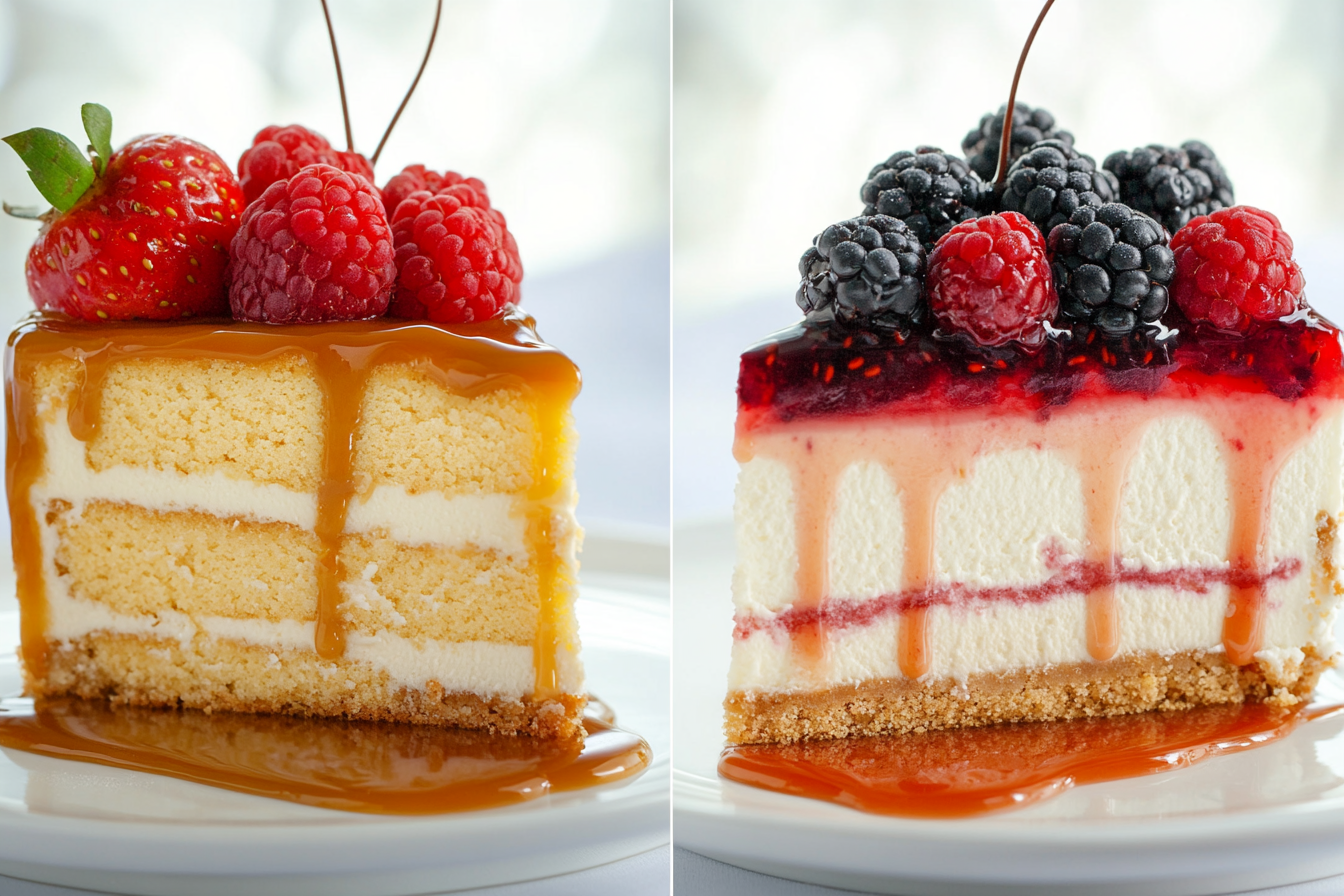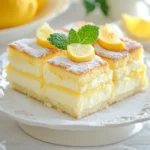Welcome to the tasty world of cream cheese and cheesecake! These two foods are often used together in recipes, but they are different from each other. Have you ever considered what makes cream cheese unique or why people love cheesecake? In this article, we will look at the differences between cream cheese and cheesecake. We will learn about their history, their health, and more. We’ll also talk about Cream Cheese vs Cheesecake and how cream cheese is an integral part of making cheesecake. So, grab a fork, and let’s enjoy this delicious journey! This version uses more straightforward language and concepts for better understanding.
What is Cream Cheese?
Cream cheese is a soft, spreadable cheese that has gained immense popularity worldwide. Its creamy texture and mild flavor make it a versatile ingredient in sweet and savory dishes. Furthermore, it’s a favorite choice for bagels, dips, and, of course, cheesecakes.
History of Cream Cheese
The origins of cream cheese date back to the 19th century in the United States. Interestingly, it was first created by a dairyman named William Lawrence in 1872. He accidentally discovered the process while trying to replicate a French cheese called Neufchâtel. Consequently, cream cheese was born, and it quickly became a staple in American households.
Nutritional Information of Cream Cheese
When it comes to nutrition, cream cheese has its pros and cons. Here’s a quick overview:
| Nutrient | Amount per 1 oz (28g) |
|---|---|
| Calories | 99 |
| Total Fat | 9g |
| Saturated Fat | 5g |
| Cholesterol | 31mg |
| Sodium | 91mg |
| Total Carbohydrates | 1g |
| Protein | 2g |
As you can see, cream cheese is relatively high in fat, contributing to its rich flavor. However, consuming it in moderation is essential, especially if you’re watching your calorie intake.
While cheesecake is a delicious treat, you may wonder how it fits into a balanced diet. Want to enjoy cheesecake without guilt? Learn more about portion control and healthier alternatives in our guide on Are Cheesecakes Healthy?
What is Cheesecake?
Now that we’ve covered cream cheese let’s focus on cheesecake. This delectable dessert has a rich, creamy filling and a crumbly crust, making it a favorite among many. But what exactly goes into a cheesecake, and how does it differ from cream cheese?
Cream Cheese vs Cheesecake: History of Cheesecake
Cheesecake has a long and fascinating history that dates back to ancient Greece. In fact, the earliest known cheesecake recipe was found in a book written by the Roman politician Cato the Elder. He described a cake made from cheese, flour, and honey served to athletes during the Olympic Games. Fast forward to today, and cheesecake has evolved into countless variations worldwide, each with its unique twist.
Cream Cheese vs Cheesecake: Nutritional Information of Cheesecake
Cheesecake is undoubtedly delicious, but it’s also essential to understand its nutritional profile. Here’s a breakdown of the common ingredients found in cheesecake:
| Nutrient | Amount per 1 slice (1/12 of a 9-inch cheesecake) |
|---|---|
| Calories | 257 |
| Total Fat | 20g |
| Saturated Fat | 12g |
| Cholesterol | 81mg |
| Sodium | 265mg |
| Total Carbohydrates | 19g |
| Protein | 4g |
While cheesecake is undeniably a treat, it’s also relatively high in calories and fat. Therefore, enjoying it occasionally is a good idea, especially if you’re mindful of your dietary choices.
Understanding the key ingredients in both cream cheese and cheesecake can help clarify their differences. Moreover, it can aid you in making informed choices when cooking or baking. help you make
Cream Cheese vs Cheesecake: Ingredients in Cream Cheese
Cream cheese is primarily made from:
- Milk
- Cream
- Salt
- Stabilizers (in some commercial varieties)
These ingredients contribute to its smooth texture and mild flavor. Furthermore, the fat content in cream cheese is what makes it so creamy and delicious. Cream cheese’s fat content makes it
Cream Cheese vs Cheesecake: Ingredients in Cheesecake
On the other hand, cheesecake typically includes:
- Cream cheese (or other cheese varieties)
- Sugar
- Eggs
- Vanilla extract
- Crust (made from graham crackers, cookies, or pastry)
Each of these ingredients plays a crucial role in creating the perfect cheesecake. The cream cheese provides the creamy filling, while the sugar and eggs help bind everything together. Additionally, the crust adds a delightful crunch, creating a satisfying contrast to the creamy filling.


The Role of Cream Cheese in Cheesecake
Now that we’ve explored the ingredients, let’s discuss the role of cream cheese in cheesecake. Its contribution cannot be overstated! Cream cheese is the show’s star, providing the signature creamy texture and rich flavor that make cheesecake irresistible.
How Cream Cheese Affects Texture and Flavor
When you think of cheesecake, the first thing that likely comes to mind is its creamy texture. This is primarily due to the cream cheese used in the recipe. However, the quality of the cream cheese can significantly impact the final product. For instance, using full-fat cream cheese will yield a more decadent, creamier cheesecake than low-fat alternatives. Consequently, if you want a decadent dessert, opt for the full-fat version!
Alternatives to Cream Cheese in Cheesecake
While cream cheese is the traditional choice for cheesecake, some people prefer alternatives for various reasons. Perhaps they’re lactose intolerant or simply seeking a different flavor profile. Some popular substitutes include:
- Ricotta cheese
- Mascarpone cheese
- Greek yogurt
- Silken tofu (for a vegan option)
Each of these alternatives will impart a unique taste and texture to the cheesecake, allowing for creativity in the kitchen. Furthermore, experimenting with different ingredients can lead to delightful surprises!
Popular Types of Cheesecake
Now that we have a solid understanding of cream cheese and cheesecake let’s delve into the cheesecake types that are available. Cheesecake is incredibly versatile, and regional tastes and available ingredients influence its variations. Furthermore, each type offers a unique twist on the classic recipe, making it a delightful experience for dessert lovers.
Cheesecake comes in many varieties! Check out our guide on Three Types of Cheesecake to explore different styles.
New York Style Cheesecake
When you think of cheesecake, New York Style is likely what comes to mind. This iconic version is known for its dense, creamy texture and rich flavor. Traditionally, it’s made with a generous amount of cream cheese, sugar, and eggs, all baked in a buttery graham cracker crust. The result is a cheesecake that is both rich and satisfying.
Interestingly, New York-style cheesecake often contains sour or heavy cream, which adds to its luxurious mouthfeel. However, this style can be high in calories, so moderation is key!

No-Bake Cheesecake
No-bake cheesecake might be your best bet if you’re looking for a quicker and easier option. This version skips the baking process entirely, relying on the refrigerator to set the filling. Typically, it’s made with cream cheese, whipped cream, sugar, and other ingredients. Consequently, no-bake cheesecake tends to be lighter and airier than its baked counterpart.
In addition, no-bake cheesecakes can be flavored in various ways, from fruit purees to chocolate. Their versatility allows for endless creativity, making them popular for gatherings and celebrations. However, they may not hold their shape as well as baked cheesecakes, so serving them chilled is crucial.

Other Variations of Cheesecake
Beyond New York Style and no-bake cheesecake, countless other variations exist to explore. Here are a few noteworthy options:
- Chocolate Cheesecake: A rich and decadent treat, chocolate cheesecake incorporates melted chocolate or cocoa powder into the filling.
- Fruit-Topped Cheesecake: This version features fresh fruit or fruit compote on top, adding a refreshing contrast to the creamy filling.
- Japanese Cotton Cheesecake is known for its light and fluffy texture. It is made with whipped egg whites, which gives it a cake-like consistency.
- Lemon Cheesecake: This zesty variation combines cream cheese with fresh lemon juice and zest, offering a bright and tangy flavor.
Each of these variations showcases the versatility of cheesecake. Consequently, there’s a cheesecake for every palate and occasion!
Equipment and Tools Needed for Making Cheesecake
Gathering the right equipment is essential before you embark on your cheesecake-making journey. Having the proper tools will make the process smoother and ensure that your cheesecake turns out perfectly. So, let’s take a look at the essential kitchen tools you’ll need.
Essential Kitchen Tools
Here’s a list of must-have tools for making cheesecake:
- Springform Pan: This pan allows easy cheesecake removal, making it a favorite among bakers.
- Mixing Bowls: You’ll need various sizes to mix the filling and crust ingredients.
- Electric Mixer: A hand or stand mixer will help achieve a smooth and creamy filling.
- Rubber Spatula: This tool is perfect for scraping down the sides of the bowl and folding in ingredients.
- Measuring Cups and Spoons: Accurate measurements are crucial for a successful cheesecake.
Furthermore, these tools will make the preparation process more enjoyable and efficient.
Baking vs. No-Bake Cheesecake Tools
While the essential tools mentioned above are applicable for both baked and no-bake cheesecakes, there are a few additional items to consider:
- Water Bath (for baked cheesecake): This method helps regulate the baking temperature, preventing cracks.
- Food Processor: Ideal for making a delicate crust from graham crackers or cookies, this tool can save you time and effort.
In addition, if you’re making a no-bake cheesecake, consider having a sturdy mixing bowl for whipping cream, as achieving the right consistency is vital for the filling. Using. Achieving
Common Problems When Making Cheesecake
Even the most experienced bakers can encounter challenges when making cheesecake. However, understanding these common problems can help you avoid them. Let’s dive into some of the typical issues and how to tackle them.
Cracking on the Surface
One of the most frustrating problems is cracking on the surface of the cheesecake. This often occurs due to rapid temperature changes, overmixing, or baking too high. Consequently, a cracked cheesecake can be disheartening, especially if you’re preparing it for a special occasion.
To prevent cracks, consider the following tips:
- Bake at a low temperature (around 325°F or 160°C).
- Use a water bath to maintain moisture and even heat distribution.
- Avoid overmixing the filling; mix just until combined.
By following these guidelines, you’ll be well on your way to a flawless cheesecake!
Soggy Crust Issues
Another common issue is a soggy crust, which can occur if the crust isn’t baked long enough or if the filling is too wet. A soggy crust can detract from the overall texture of the cheesecake, leaving you feeling unsatisfied. Fortunately, there are simple solutions to this problem.
To achieve a crispy crust, try these tips:
- Pre-bake the crust for about 10 minutes before adding the filling.
- Ensure that the crust mixture is well-combined and pressed firmly into the pan.
- Consider using a mixture of graham crackers and nuts for added texture.
With these strategies, you can ensure that your crust remains firm and delicious!

Solutions and Tips for Perfect Cheesecake
Now that we’ve identified some common problems when making cheesecake, let’s discuss solutions and tips to ensure your cheesecake turns out perfectly every time. Furthermore, these strategies will help you enhance the flavor and texture, making your dessert a crowd-pleaser! These strategies will also.o
Preventing Cracks
As mentioned earlier, cracks can be a significant concern when baking cheesecake. However, with a few preventive measures, you can minimize the risk. Here are some effective tips:
- Room Temperature Ingredients: Always use room temperature cream cheese and eggs. This ensures a smooth mixture and helps the cheesecake bake evenly. Room-Temperatureroom-temperature
- Gentle Mixing: Mix the ingredients quickly to avoid incorporating too much air, which can lead to cracks during baking.
- Cooling Gradually: After baking, turn off the oven and leave the cheesecake inside for an additional hour. This gradual cooling process helps prevent sudden temperature changes that can cause cracks.
By following these tips, you can significantly reduce the chances of cracks in your cheesecake, resulting in a beautiful and smooth surface. Following these tips,
Achieving the Perfect Crust
The crust is a crucial cheesecake component, providing a delightful contrast to the creamy filling. However, achieving the perfect crust requires attention to detail. Here are some tips to ensure your crust is both delicious and structurally sound:
- Use Fresh Ingredients: Fresh graham crackers or cookies yield better flavor and texture. Stale ingredients can lead to a lackluster crust.., while stale.
- Press Firmly: When forming the crust, press the crumbs firmly into the bottom and up the sides of the pan. This creates a sturdy base that holds up well during baking.
- Consider Adding Sugar: A little sugar in the crust mixture can enhance the flavor and help the crust hold together better.
With these strategies, you can create a crust that perfectly complements your cheesecake.

Conclusion: Cream Cheese vs. Cheesecake – Final Thoughts
In conclusion, understanding the differences and similarities between cream cheese and cheesecake enriches your culinary knowledge. Cream cheese is a versatile ingredient that enhances the flavor and texture of cheesecake, while cheesecake itself is a beloved dessert with countless variations.
Remember the tips and tricks this article discusses as you experiment with different recipes. Whether you’re baking a classic New York cheesecake, trying a no-bake version, or even exploring unique flavors, the key is to enjoy the process. Furthermore, sharing your creations with friends and family can make the experience even more rewarding!
So, the next time you find yourself in the kitchen, don’t hesitate to whip up a delicious cheesecake. After all, the joy of baking lies in creating something delightful and sharing it with those you love. Happy baking!
Cream Cheese vs Cheesecake: Frequently Asked Questions (FAQs)
As we wrap up our exploration of cream cheese vs. cheesecake, let’s address some frequently asked questions. These queries often arise for both novice and experienced bakers alike.
Can you substitute cream cheese for cheesecake?
Yes, you can substitute cream cheese for cheesecake! While cream cheese provides a rich and creamy texture, alternatives such as ricotta, mascarpone, or Greek yogurt can also work well. However, remember that each substitute will impart a different flavor and texture, so choose according to your preference.
What’s the difference between cream cheese and mascarpone?
Cream cheese and mascarpone are creamy but differ in texture and flavor. Cream cheese is firmer and tangier, while mascarpone is softer and sweeter. Consequently, mascarpone can lend a luxurious creaminess to desserts, making it a popular choice in Italian recipes.
Is cheesecake a cake or a pie?
This is a common debate among dessert lovers! Cheesecake is technically classified as a custard pie due to its filling and crust. However, its cake-like texture often makes people refer to it as a cake. Ultimately, it’s a delicious dessert that defies strict categorization!



